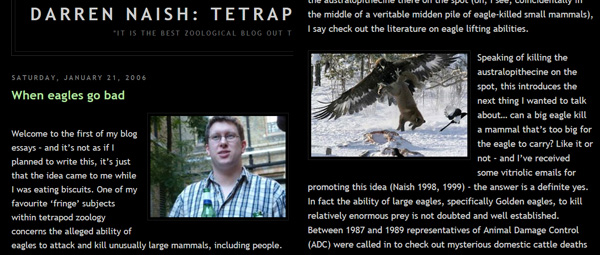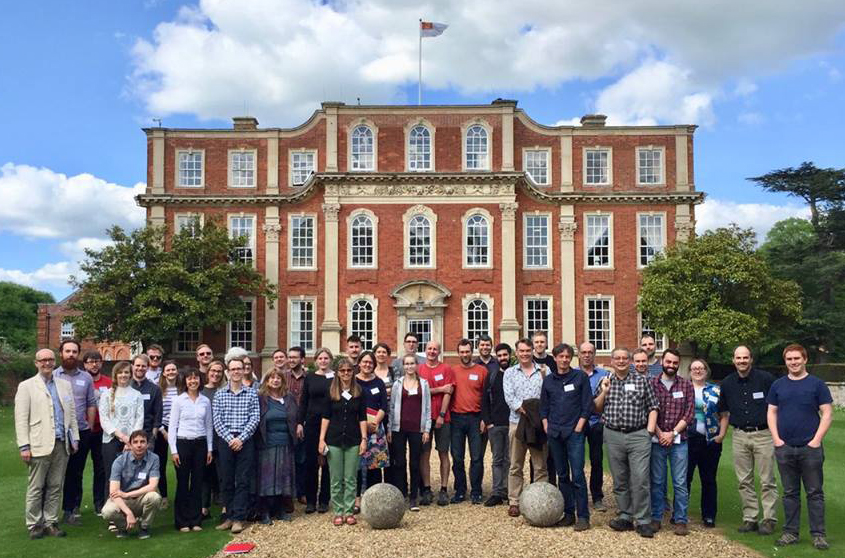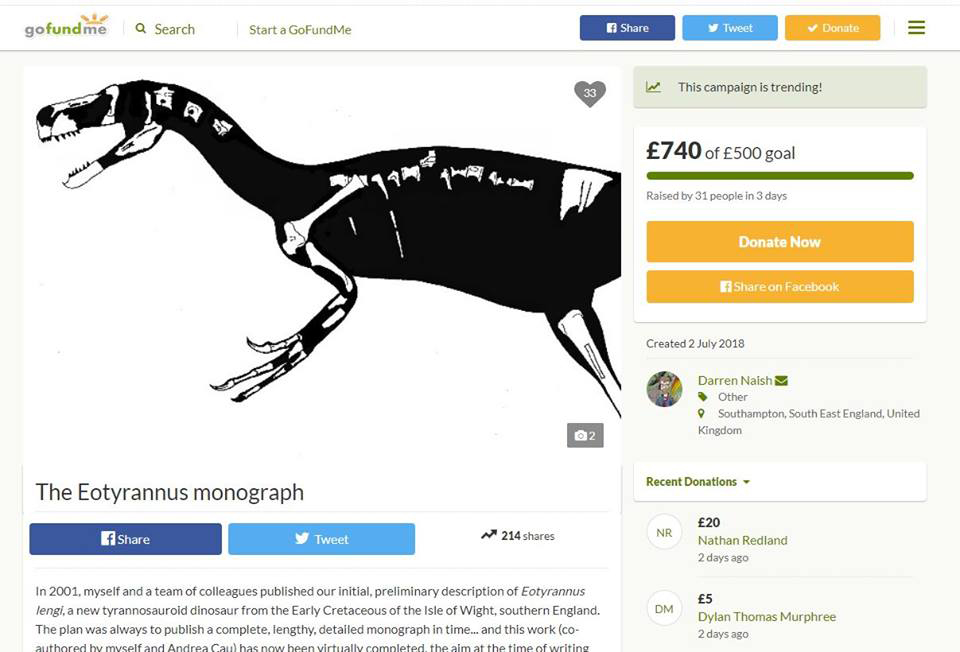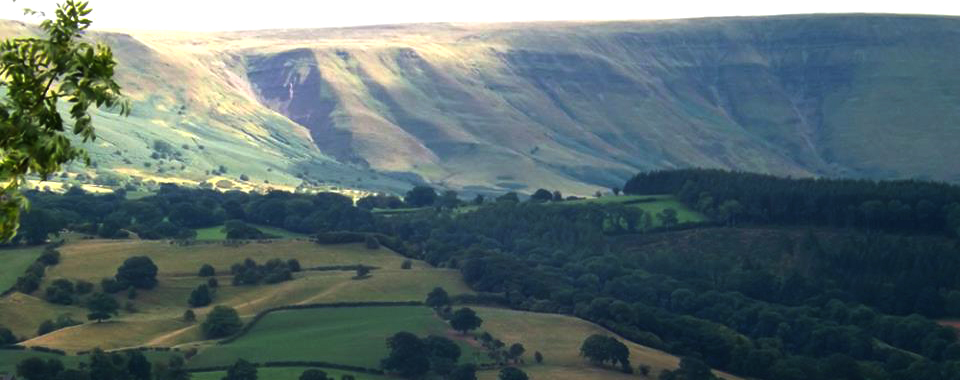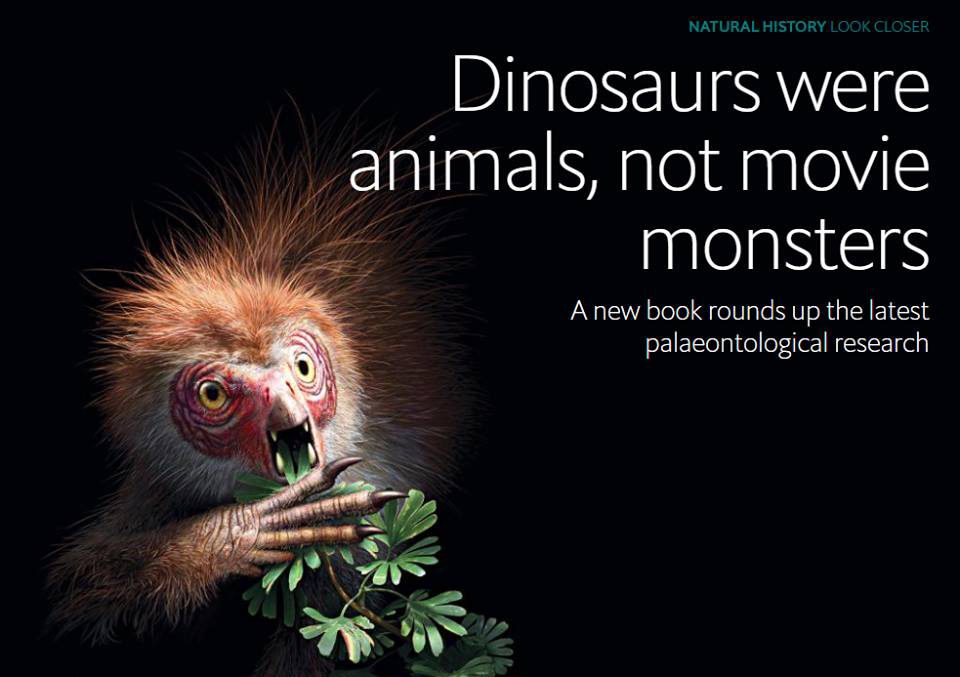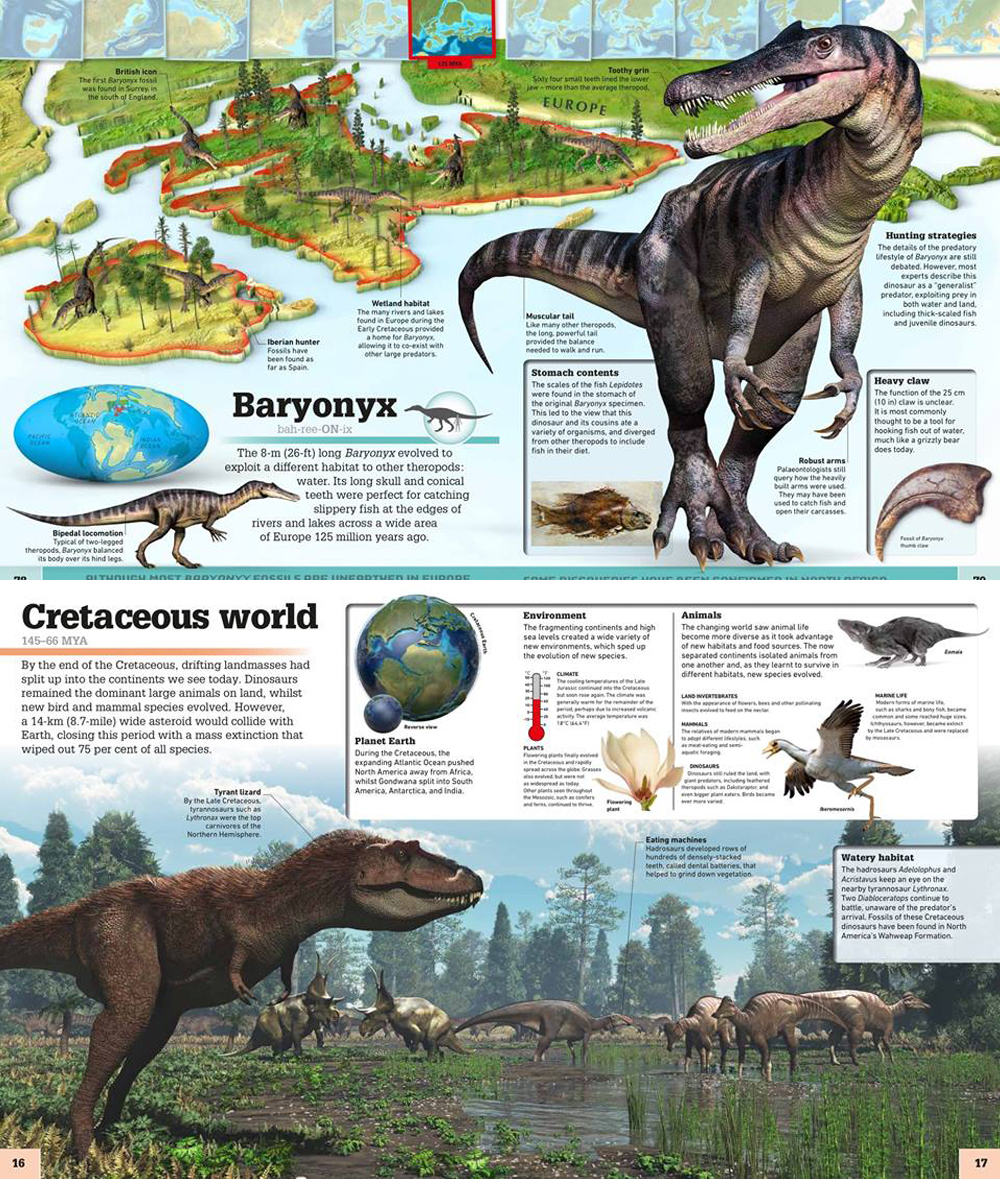Yet again a year has passed and yet again it’s time to review events relevant to the TetZooniverse, so here we are at TetZoo’s 13th birthday (January 21st 2006 being the date on which the blog first came into being). As per usual, I’m going to discuss, comment on or mention all those TetZooniverse things that I deem worthy of discussion, comment or mention. And, as usual, I implore you not to read this if the thought of me writing about my own achievements and adventures sounds arrogant or worth a miss. Still here? Ok, we proceed…
Caption: once again I’m going to begin by reminding you of how it all began, back in 2006… you can see that very first article (should you want to) here. Images: Darren Naish.
Our story begins in late January 2018. Birds (owls and rollers, among others) were still keeping me busy as goes The Big Book, and academic work on ichthyosaurs, pterosaurs and sea monsters (of the cryptozoological sort) was underway. It’s a reminder (as if another were needed) of how slowly it takes for academic projects to come together to note that none of those projects have yet seen print, more than a year later. Fossil bats – covered only because I suddenly suffered bat guilt – got a little coverage at TetZoo during February. I visited Hill Head, West Wittering and Swanwick to see grebes, divers, waders and gulls. The conditions were mostly cold and windy but clear and sunny, which is great for looking at water- and seabirds.
Caption: there are so many great places to see water- and seabirds around the coasts of the UK. One of my favourite haunts at the moment is Swanwick in Hampshire. Teals at left; Brent geese at right. Image: Darren Naish.
Dinosaurs in the Wild (DITW) opened for its final, London-based run at the start of February. If you’re a regular reader you’ll already be familiar with this interactive, science-based visitor attraction so I won’t be saying much more about it today. If you don’t know what I’m talking about and are curious, see Dinosaurs in the Wild: An Inside View at TetZoo ver 3 and The Last Day of Dinosaurs in the Wild here at ver 4. I did various promotional events for DITW from February to June and met science journalist and author John Pickrell at the exhibition during February. Also in February, I wasted time submitting a grant application which was ultimately unsuccessful – more on that later.
Caption: scenes from Dinosaurs in the Wild. At left, your humble author with John Pickrell (and friend: John is the one not holding the plush tyrannosaur). At right: myself, Siouxsie the Dakotaraptor, and Chris Packham. Images: Darren Naish, Megan McCubbin.
A TV thing filmed at Colchester Zoo during October 2017 appeared on BBC4, titled ‘The Incredible Science of Temperature’ and presented by Helen Czerski. I was filmed discussing, with Helen, what influence global temperatures have had on the distribution of ectothermic reptiles (qualifier because not all non-bird reptiles are ectothermic), and on the physiology and behaviour of Komodo dragons. It felt, at the time, like a total disaster but I’m pleased to say that the parts of my performance included in the show weren’t too bad (the relevant episode is online here). Fighting blue tits, Leguatia, and an article about Mark Witton’s palaeoart appeared at TetZoo during this part of the year. Remember that TetZoo was still hosted at SciAm at this point.
In March I assisted with a local beach clean event. I don’t talk about these to brag about my public service (heavens, no), but to help maintain awareness of plastic pollution and the problems facing marine environments today, and also to remind those of you reading this that you can help by getting involved with local environmental groups.
Caption: beach cleaning is always such a joy (am being ironic). Here’s a haul after just a few hour’s work. Image: Darren Naish.
March was also the month in which Paul Barrett and I compiled our suggested list of corrections and updates for the second edition of Dinosaurs: How They Lived and Evolved. Again, I don’t need to say much about this here since the story behind the second edition was recently covered here in, err, The Second Edition of Dinosaurs: How They Lived and Evolved. Thanks again to those who provided help in compiling corrections, to those who’ve said positive things about the book and to those who’ve purchased it and helped spread the word about it.
Caption: Milo the Neotropical giant toad - at right - now lives at Tet Zoo Towers, but his original home was the BBC Natural History Unit, at BBC Bristol. Like Milo, I spent time at BBC Bristol during 2018. Why? Well… we shall see. Images: Darren Naish.
I engaged in an online interview with the brilliant Aron Ra who I’ve long been familiar with but had not previously spoken to. We discussed TetZooCon, the Tetrapod Zoology project, my books, serial mis-educator David Peters, and more. The interview – part of Aron’s RaMen series – is online here. I also used our virtual meeting as an excuse to invite Aron as a speaker to TetZooCon 2018 since, by virtue of good timing, he was going to be in the UK at exactly the right time. More on TetZooCon later. Oh: I joined instagram in March, wholly because I read an article by a scientist bemoaning scientists who join instagram. My review of Jonathan Kane et al.’s most worthy book God’s Word or Human Reason? appeared at TetZoo in late March, as did a short review of everything columbiform. By now, the substantial passerine section was being done for The Big Book which surely meant that completion of the enormous bird section was in sight, right?
Caption: work on The Big Book (my in-prep textbook The Vertebrate Fossil Record) mostly involved birds across 2018. In cases, as here, I had to revamp some old illustrations. This image shows old (at right) and new images of Aepyornis… and surely I won’t need to revamp Aepyornis AGAIN, right? Some of you will know what I’m getting at. Image: Darren Naish.
Sunday Brunch, publishers, duckbills, sexual selection. And so to April. As – once again – part of the whole promotional Dinosaurs in the Wild thing, I appeared on the TV show Sunday Brunch… which I’ve never watched but is, by all accounts, pretty popular. It went well and I got to talk about our current knowledge of Mesozoic dinosaurs a fair bit as well as promote Dinosaurs in the Wild, but what might have been the most memorable section of the interview was at the end where presenter Tim Lovejoy asked what the future might hold in store as goes the evolution of life on Earth. Ever the optimist, I told them about the impending mass extinction and the death of biological diversity at the hands of humanity, and that was that.
Caption: a view from the set of Sunday Brunch, April 2018. Ash, Chrissie and a hatchling Dakotaraptor at left. Image: Darren Naish.
Caption: Chrissie, Darren and the Dakotaraptor hatchling, live on Sunday Brunch on April 8th 2018. Image: (c) Sunday Brunch/Channel 4.
In an effort to get the planned Dinosaurs in the Wild book off the ground, I physically dragged myself from publisher to publisher. So many meetings, and all in vain. While at William Collins, however, I did get to see the complete set of the New Naturalist series and, via publisher Myles Archibald, got to hear the backstory to that Too Big to Walk book… the one by ol’ BJ Ford in which he asserts his uncanny ability to finally get dinosaurs right (they were all aquatic, you see). More on that shortly. I also had a meeting about another planned cryptozoology-based TV series. I can basically guarantee having two or three such meetings about the same sort of project every year. They never go anywhere. Yet.
Caption: the Collins New Naturalist books on display at the Collins office in London. Most of us own at least a few of these volumes. Image: Darren Naish.
My article on why duckbilled dinosaurs really shouldn’t be called duckbilled dinosaurs appeared in April. It includes a significant gaff and a follow-up article is due to be published here within the next several weeks. The second part of of my review of the Indiana University Press 2014 hadrosaurs volume was also published in April: the first part of my review is one of those articles that SciAm removed due to perceived problems with image use so isn’t currently online. I’ll republish it here at ver 4, eventually.
Caption: attendees of the Sexual Selection meeting at Chicheley Hall, Buckinghamshire. Image: Rob Knell.
I attended the Royal Society Sexual Selection meeting at Chicheley Hall in Buckinghamshire in early May and chaired one of the sessions. A TetZoo article about the meeting can be found here at ver 3.
Caption: I went to Tintagel, north Cornwall, in May 2018. Here’s a scene of the coastline there, with seabirds. Image: Darren Naish.
Naish v Ford. The biggest event of May was the debate with Brian Ford at Conway Hall, hinted at above. It seems that this was actually the official launch for Mr Ford’s book – it’s hard to tell as I didn’t see anybody buy a copy – but it was more like a structured debate, the two of us presenting opposing viewpoints on the palaeobiology of Mesozoic dinosaurs before responding to questions from the floor. Events were reported on twitter via #FordvNaish, and my talk can be seen here online.
Caption: at left, the cover slide for the event. At right: protesters outside Conway Hall, as imagined by Gareth Monger. Well done if you recognise the reference. Images: Darren Naish, (c) Gareth Monger.
I’ve written about Brian Ford and his ideas at least twice before: both in print for an invited article in Laboratory News (Naish 2012) and at TetZoo ver 3. Needless to say, I think he’s flat-out wrong and also guilty of conspiracy mongering, self-aggrandisement (he has literally compared himself to Galileo) and crankery (“nobody’s smart but me!”), among other things. Evaluating the talks is difficult due to the fact that I’m just about never happy with the presentations I give; in any case, John Conway and I already dissected the event at some length in an episode of the podcast. Having said that, Brian asserted that everyone was getting dinosaurs wrong, and assert is basically all he did. I would think that the mostly negative responses that have been directed toward Mr Ford’s ideas would have been sufficient to make him realise that he could very well be wrong as goes his take on dinosaurs, but… nope… he’s still at it (at least, judging from comments he’s recently been making at ResearchGate). I don’t want to give him more publicity than I already have, but if I need to respond to him again, I will.
Caption: Darren Naish (left) and Brian Ford (right). Image: Luke Muscutt.
Podcats, Jurassic Park at 25, lego at Metro. Having mentioned Conway, we released a few episodes of the podcast – the Tet Zoo podcats or Tetrapodcats – throughout the first half of the year, but we’re still nowhere near having anything like a regular schedule. Mostly this is because John is incredibly lazy, and unproductive to boot. An added factor is that I ‘accidentally’ cleaved through a buried telephone cable in the garden with a spade one day, but I’m sure that that’s coincidental. The new cover for Dinosaurs How They Lived and Evolved, produced by the excellent Bob Nicholls, was released in May – sooner than expected. More on that below.
Caption: in May 2018, I (with my kids Will and Emma) attended the Portsmouth Comic Con, and here are some scenes. Not really relevant to TetZoo, but what the hell. Images: Darren Naish.
Hunting Monsters – the cryptozoology book that I’ve now mentioned here on some number of occasions (Naish 2017) – was mentioned on the TV show Jeopardy in early June, wow. Thanks to whoever it was who brought my attention to this. June 2018 was also the time at which Jurassic Park – a movie you might have seen or heard about – celebrated its 25th birthday. A lot of the fan response to the original Jurassic Park – we see a lot of it in vertebrate palaeontology, in fact it comes around every few years – is, my apologies for seeming rude here, mostly vacuous and doesn’t come from a position all that well informed as goes the backstory and making-of the movie. Make of that what you will; whatever, my three Jurassic Park articles are here, here and here, and my liberal use of Jurassic Park toys reflects my best efforts to circumvent the rules regarding image use at SciAm. For all that, they still objected so much to my use of a photo of an issue of National Geographic that they removed it. So I created my own version of the cover.
Caption: Hunting Monsters appears on Jeopardy. Image: (c) Jeopardy, NBC/American Broadcasting Company.
Another bit of Dinosaurs in the Wild promotion happened in late June when – together with palaeontologist Alessandro Chiarenza and actor Ross Cooper – I got to sit in a studio with Natasha Salmon and build Jurassic World lego, all the while talking about dinosaurs. This was for the Metro newspaper, and what fun it was. I even got to keep some of the lego. I also had an article on dinosaurs – specifically on how our perception of their appearance has changed – appear in the Independent Online in mid July. It’s here.
Caption: playing with Jurassic World: Fallen Kingdom lego at the Metro offices. I’m not entirely sure why Natasha is making the face she is. Image: (c) Metro.
Eotyrannus 2018. During late June I participated in the 2018 BioTweeps conference (an online, Twitter-based conference in which attendees present their ‘talks’ via a series of threaded tweets), my presentation being ‘Eotyrannus and the History of Tyrant Dinosaurs’ (abstract here). As an invited presenter I got to tweet as much as I wanted to in the allotted 30 minute slot. It was a very rewarding experience (with a massive, global reach, I might add), and my thanks to Dani Rabaiotti and Anthony Caravaggi for getting me involved. You can see my presented tweets here (with an addendum here).
Caption: Naish at BioTweeps 2018. Image: Darren Naish.
Having mentioned Eotyrannus… as some of you know, I am (still) committed to publishing the monograph on this dinosaur, and while I failed to get the damned thing into print in 2018, I promise that this will happen in 2019. It’s not for want of trying: substantial progress was made on the post-review version of the manuscript throughout the year, it’s just that I was never able to commit sufficient time to getting it finished. Silly old me for leaving professional scientific research and becoming a freelancer. My co-author Andrea Cau continues to be a most worthy collaborator.
Caption: the Eotyrannus holotype, in its storage boxes, at Dinosaur Isle, Sandown, Isle of Wight… as it looked in 2012. One day my work on this dinosaur will be published. Image: Darren Naish.
I mentioned earlier that I was unsuccessful in obtaining a grant – that’s no big deal, most grant applications in science are unsuccessful. Said grant was an attempt to win the money I require to publish an open-access version of the Eotyrannus monograph. On the advice of colleagues, I tried a different approach and set up a gofundme campaign to raise the money aaaand succeeded in raising it (and a bit extra) in about 5 hours. WOW.
Caption: Eotyrannus at gofundme — SUCCESS. Image: gofundme.
Speaking of long-running projects that never seem to reach completion, I and colleagues put what are supposed to be the final touches to a PhyloCode Companion Volume article on theropods during the summer. I’m also part of the team that produced the volume’s sauropod and sauropodomorph articles. But they have a somewhat different fate from the theropod article, that’s all I’ll say for now.
Caption: this image has to go somewhere and here is as good a place as any. It’s not made by me, but by naughtyhippo (if that is her real name). Available on merchandise here. Image: Darren Naish.
Goodbye SciAm. July was a significant month as goes TetZooniverse things as, on July 25th, I reached a funding goal at patreon. Regular TetZoo readers will know (my god, how many times have l mentioned it?) that I was not happy with the way things were going at SciAm. Their total clamping down on image use and removal of various of my articles was pretty much the last straw: blogging there was proving more trouble that it was worth, despite the major kudos of being attached to the SciAm brand. Achieving the relevant goal meant that I could leave (as a freelancer, I’m dependent on earning from my writing: it is my primary income) and set up shop as an independent blogger once more (harking back to the days of TetZo ver 1, 2006). Despite my unhappiness with SciAm, walking away was not a decision I took lightly. The very last TetZoo ver 3 was published on July 31st, and here we are at ver 4, at the same website at the podcast. Thanks, as ever, to the patreon supporters who made this possible.
Caption: leaving SciAm means that I’m now entirely dependent on support at Patreon. What a gamble. As of right now, the site needs updating. Image: Darren Naish.
August began with the taking on of an exciting job in the museums world. It involves an exhibition relevant to our interests, but it won’t go live until 2020 and I won’t be talking about it until then, sorry. I’ll give you a clue and say that it has meant spending time in Cornwall, one of my favourite parts of the UK. Also during August, I spoke to New Scientist about megalodon in view of a scientific documentary called Meg. I’m not, technically, an expert on megatooth sharks but I have written about them several times: there’s a section in Cryptozoologicon Volume I (Conway et al. 2013) and another – as yet unpublished, of course – in the chondrichthyan section of The Vertebrate Fossil Record.
Caption: from time spent in Hay-on-Wye. This is Hay Bluff. Image: Darren Naish.
Articles on the potential domestication potential of non-bird dinosaurs and mastigures (or spiny-tailed agamas) appeared at TetZoo. Together with the family, I visited Hay-on-Wye, the fabled Town of Books of the Welsh borders (and filming location for certain iconic scenes in An American Werewolf in London). There aren’t half as many book shops in Hay-on-Wye as there used to be, but there are enough to make a visit very much worthwhile if you’re a bibliophile. I made a great number of amazing discoveries – beware, there’s a dedicated natural history bookshop (C. Arden) – and am really happy that I finally took the time to go there.
Caption: don’t go to Hay-on-Wye, it will be bad. Image: Darren Naish.
As I mention every now and again, I continue to remain involved in technical scientific research as and when I can, and late August saw the publication of my then-newest paper: a study of pelvic neural anatomy in pterosaurs and what the relevant details might mean for ecomorphology, co-authored with Liz Martin-Silverstone and Dan Sykes (Martin-Silverstone et al. 2018). This was the second 2018 paper that included an analysis of Vectidraco – a small Cretaceous azhdarchoid pterosaur I and colleagues described in 2013 (Naish et al. 2013) – the other being Rachel Frigot’s study of pelvic musculature included within the Geological Society special volume New Perspectives on Pterosaur Palaeobiology (Frigot 2018). A discussion on the new paper was provided here.
Caption: at left, an illustration of the Vectidraco pelvis, some key features labelled. At right: a pterosaur montage produced for the TetZoo article on pterosaur palaeoneurology. Images: Darren Naish.
September 2nd was the very final day of Dinosaurs in the Wild. I went on a final tour, attended the staff party, and said all those sad, final goodbyes. All things must come to an end, but hope remains that DITW will be able to open its doors again one day.
Caption: me (at left) with Tim Haines - of Impossible Pictures, Walking With Dinosaurs, Primeval and so on - doing some Dinosaurs in the Wild promotion for radio during May 2018. Image: Darren Naish.
Dougal Dixon, Crystal Palace, DHLTE: 2nd ed. Early September also brought the devastating news of the calamitous fire at Rio’s National Museum, a blow for human knowledge as a whole but especially for our Brazilian friends and colleagues. While at the museum in 2013, I took some reasonable number of photos, so have been submitting them to Brazilian colleagues. In happier news, September also saw the Dougal Dixon event at London’s Conway Hall (covered here at TetZoo) in which Dougal and I discussed his work and projects in front of a pretty substantial crowd. Original art, models and more were in attendance – it was great.
Caption: at Conway Hall, for the After Man-themed event with Dougal Dixon. Images: Darren Naish.
Just a few days later, and I was speaking at another London-based event, this time the Crystal Palace Dinosaurs Days event, part of the Heritage Open Days weekend occurring across the UK. Other speakers were in attendance too, and we had special up-close access to the models. I’m surely repeating myself, as all of this was covered in the December 2018 article Up Close and Personal With the Crystal Palace Dinosaurs. As you may know, part of the reason for the publicity push surrounding the models is that funding is desperately needed for their care and upkeep, and September 2018 saw the launch of a crowd-funded project to get a bridge to the models constructed (said bridge then allowing the access that can otherwise only be obtained on rare occasion). The project reached its target (which was over £70,000) in December, which is excellent and exhilarating news.
Caption: special access to the islands at Crystal Palace, what a treat. Here, I’m talking about what the Victorians thought about ichthyosaurs. For more, see Up Close and Personal With the Crystal Palace Dinosaurs. Image: Emma Wain.
The second edition of Dinosaurs: How They Lived and Evolved – my Natural History Museum book with Paul Barrett (Naish & Barrett 2018) – saw print in September. Again, thoughts on this have already appeared at TetZoo so I’ll avoid repeating things here. A review appeared in The Economist, which is kind of a big deal. Summer 2018 also saw the publication of the Russian edition of the book. It has the text of the second edition but the cover of the first.
Caption: screengrab from the Economist’s review of the second edition of Dinosaurs: How They Lived and Evolved. The lead quote comes from Bob Nicholls, creator of the fuzzy Tianyulong we see at left. Image: (c) Economist.
TetZooCon 2018! And so to October, and the TetZoo-themed event of the year, by which I mean TetZooCon. As covered here on the blog, 2018’s TetZooCon was the first two day TetZooCon ever, and by far the biggest and (I think) the best. Speakers and presenters included Ian Redmond, Mark O’Shea, Aron Ra, Dougal Dixon and Gert van Dijk (on stage for a SpecBio discussion), Katrina van Grouw and myself. John Conway led a palaeoart workshop that occurred as a parallel session to some of the talks and I led a post-con fieldtrip to Crystal Palace the day after. A MonsterTalk episode with Blake Smith – done as a piece of TetZooCon promotion but mostly revolving around Jurassic Park – was released in early October (it’s here; episode 172).
Caption: scenes from TetZooCon 2018. At left, Albert Chen discusses TetZoo. At right: a box of Dinosaurs in the Wild plushies. Images: Darren Naish.
Hey, I had to turn down a free, all-expenses-paid birdwatching trip to Cadiz in Spain because it clashed with TetZooCon, talk about bad luck. The success of TetZooCon 2018 means that a 2019 event is just about guaranteed (or, it is now that John and I are back on speaking terms again); it will again be a two-day event but I can’t yet say any more than that. News will be announced as and when I have it.
Caption: TetZooCon 2018 included a dedicated SpecBio discussion, and here’s Gert van Dijk talking about his own Furaha project, at said event. Image: Darren Naish.
Dorling Kindersley. It was around this time in the year that I and Chris Barker put the finishing touches to a new kid’s book we’ve put together for Dorling Kindersley, titled Where on Earth? Dinosaurs and Other Prehistoric Life. I wouldn’t mention this (seeing as the book isn’t published yet), but it’s already being advertised.
Caption: screengrabs from the in-press Where on Earth? Dinosaurs and Other Prehistoric Life, by Chris Barker and Darren Naish. Images: Barker & Naish/Dorling Kindersley.
In fact, I did a huge amount of work for Dorling Kindersley during 2018 as I and colleagues at DK worked hard to overhaul their entire prehistoric animal picture library. One volume that benefited from this overhaul – John Woodward’s The Dinosaurs Book (Woodward 2018) – was published during the year (I was consultant). It should be obvious to anyone paying attention to children’s books on dinosaurs that this overhauling has resulted in a massive improvement as goes the sorts of images the books now contain.
Caption: Castle Urquhurt, as photographed from the surface of Loch Ness (a scene from 2014, not 2018). Image: Darren Naish.
Loch Ness, 99% Invisible. I’ve mentioned once or twice here my communications with Professor Neil Gemmell and my role in his eDNA-based work on the biology and ecology of Loch Ness. Neil and I met up in 2017 to discuss this work (a 2018 article on the backstory to Neil’s research – one of several – can be found here), and I published two magazine articles on the subject during the year: one in a kid’s magazine in October (Naish 2018a) and another for a more adult audience in December (Naish 2018b). It’s very easy to misunderstand, or ‘mis-frame’, this project as “SCIENTIST WASTES TAX-PAYER MONEY ON LOCH NESS MONSTER NONSENSE” and, indeed, at least one author did make this misunderstanding during the year. What should be noted, I’d argue, is that this is and was a phenomenally successful science outreach programme wherein the Loch Ness Monster was used as the hook to get journalists to cover eDNA and ecological and genetic research, and as such it was absurdly successful (Naish 2018a, b).
Caption: artwork accompanying Naish (2018b). I didn’t write that caption, since the ‘For centuries’ thing is not true. Image: (c) BBC Focus, Naish (2018b).
Late October also saw the release of an episode of the 99% Invisible podcast in which myself, Bob Bakker and John Conway discussed the portrayal of Mesozoic dinosaurs in art. The episode is called Welcome to Jurassic Art and can be found here. Alas, the three of us didn’t really sit around talking (though I have spoken to Bob Bakker, in person, on a few occasions). Instead, our interviews were recorded at different times, at different places. Anyway, it worked out alright.
Caption: one of the highlights of the ZSL book-themed event — Jules Howard tells us about the digital duck vagina app. Image: Darren Naish.
The ZSL zoology books evening. Articles on New Living Animals We Want to Find, Aldrovandi’s monstrous rooster, the second edition of Dinosaurs: How They Lived and Evolved and the pouches of the Sungrebe appeared at TetZoo during November. The article on Aldrovandi’s rooster includes a notable gaff, and an update is due to appear here soon (there is not enough time to do all this stuff, argh!!). Mid-November also saw the Zoological Society of London event From Stoned Sloths to Farting Fish: Comical Tales from the Animal Kingdom, in which myself, Dani Rabaiotti, Jules Howard and Lucy Cooke discussed our adventures in the world of zoology-themed publishing. I mostly spoke about dinosaur sex.
Caption: crew at the public engagement event of December’s Popularising Palaeontology event. L to r: Elsa Panciroli, Mark Witton, Chris Manias, Becky Wragg Sykes, Darren Naish. Image: Darren Naish.
Early in December, I stayed in Bournemouth, UK, for the Joint Scientific Meeting of the British Herpetological Society and Amphibian and Reptile Conservation, which has become one of my favourite small meetings. I spoke at last year’s event but not this one. And, later in the month, I attended the Popularising Palaeontology workshop, organised by Chris Manias and hosted by King’s College, London where I listened to some great presentations and participated in the public engagement event.
Caption: herpetology-themed snap cards, obtained at the Joint Scientific Meeting of the British Herpetological Society and Amphibian and Reptile Conservation. Image: Darren Naish.
And that brings us up to January, a month mostly spent in China and away from the long list of TetZoo-related things I aim to complete in 2019. While in China (specifically, Zigong in Sichuan) I visited Panda Base (properly Chengdu Research Base of Giant Panda Breeding) and the Zigong Dinosaur Museum, among other places.
Caption: the entrance to Chengdu Research Base of Giant Panda Breeding, Sichuan, China. Image: Darren Naish.
Thus far, the year’s only TetZoo articles have been those on Heilmann’s Proavis and the life appearance of sauropods. I so wish I could publish more – there is still so much to do. On that note, here’s this…
Achievements for 2018: the pterosaur palaeoneurology paper (Martin-Silverstone et al. 2018), Tetrapod Zoology ver 4 is launched, 2nd edition of Dinosaurs: How They Lived and Evolved sees print (as does Russian translation), Loch Ness magazine articles (Naish 2018a, b), money raised for Eotyrannus monograph, the Dorling Kindersley overhaul, biggest and best TetZooCon so far.
Failures for 2018: not finishing the Eotyrannus monograph, not finishing The Big Book, not making any progress on the Tetrapod Zoology books, Cryptozoologicon Volume 2 or the various dinosaur-themed books planned with John Conway.
Caption: toy thylacines - did you know that there are this many? The grey 3D-printed one - and the painted version at far right (the sitting one) - were obtained at TetZooCon 2018 and were made by Rebecca Groom of palaeoplushies. Image: Darren Naish.
Ok, so that’s that. How does the year’s blogging do in terms of group representation?
Miscellaneous Musings
Book Review: God's Word or Human Reason? An Inside Perspective on Creationism
Coming Soon in 2018: Katrina Van Grouw's Unnatural Selection
TetZoo ver 3 and a Dark Day for the Dissemination of Knowledge
Comical Tales From the Animal Kingdom, a Zoological Society of London Meeting
The Much Belated Final Part of the Tetrapod Zoology 12th Birthday Event
Mammals
Lepidosaurs
Pterosaurs
Non-avialan dinosaurs
Eberth and Evans's Hadrosaurs, a Book Review, Part 1 (currently offline due to action by SciAm)
New Dinosaur Books, Part 2: Ben Garrod’s ‘So You Think You Know About… Dinosaurs’ Series
The Second Edition of Naish and Barrett’s Dinosaurs: How They Lived and Evolved
Birds
Cryptozoology
SpecBio
So there we have it. Clearly, 2018 was dominated by non-bird dinosaurs and by articles that can only be classified as generic or miscellaneous and weren’t dedicated to any specific tetrapod group. Amphibians, croc-line archosaurs and so on received no coverage whatsoever. All in all, then, a total and epic failure of what I’ve been trying to achieve here. I figure, by now, that I should stop caring and just aim to write about whatever it is that I write about.
Caption: oh, fish. Image: Darren Naish.
So — happy 13th birthday, Tetrapod Zoology. As ever, I aim to continue to publish as much as I can here: to both present new ideas, new reviews and new takes on zoological topics of interest, and to up-date and correct those things I’ve covered in the past. There is so much to do, and finding time for blogging remains perpetually difficult in view of workload and the never-ending chasing of finances. Plus there’s that textbook I so desperately want to see finished. Here’s your reminder that I’m wholly reliant on funding at patreon, and that I would be able to devote just about all of my work-time to these projects – blogging and the textbook, and the other TetZooniverse-relevant books – if more TetZoo readers were prepared to support me. Huge thanks to those who do so already. Come back soon for another thrilling instalment.
For previous Tet Zoo birthday articles, see...
It is with some dismay that I announce Tet Zoo's first hemi-decade
Tetrapod Zoology 10th-Birthday Extravaganza, Part 1: 2015 in Review
Tetrapod Zoology 10th Birthday Extravaganza, Part II: the Rest of 2015 Reviewed
Tetrapod Zoology 10th-Birthday Extravaganza, Part 3: Tet Zoo's Tetrapod Treatment in 2015
The Much Belated Final Part of the Tetrapod Zoology 12th Birthday Event
Refs - -
Conway, J., Kosemen, C. M. & Naish, D. 2013. Cryptozoologicon Volume I. Irregular Books.
Frigot, R. A. 2018. Pelvic musculature of Vectidraco daisymorrisae and consequences for pterosaur locomotion. In Hone, D. W. E., Witton, M. P. & Martill, D. M. (eds) New Perspectives on Pterosaur Palaeobiology. Geological Society, London, Special Publications 455, 45-55.
Martin-Silverstone, E., Sykes, D. & Naish, D. 2018. Does postcranial palaeoneurology provide insight into pterosaur behaviour and lifestyle? New data from the azhdarchoid Vectidraco and the ornithocheirids Coloborhynchus and Anhanguera. Palaeontology 2018, 1-14. doi: 10.1111/pala/12390
Naish, D. 2017. Hunting Monsters: Cryptozoology and the Reality Behind the Myths. Arcturus, London.
Naish, D. 2018a. Will we ever find Nessie? In Lipscombe-Southwell, A. (ed) BBC Focus Big Book of Mind-Blowing Answers, pp. 16-21.
Naish, D. 2018b. The genetic hunt for Nessie. BBC Focus 329, 66-71.
Woodward, J. 2018. The Dinosaurs Book. Dorling Kindersley, London.

